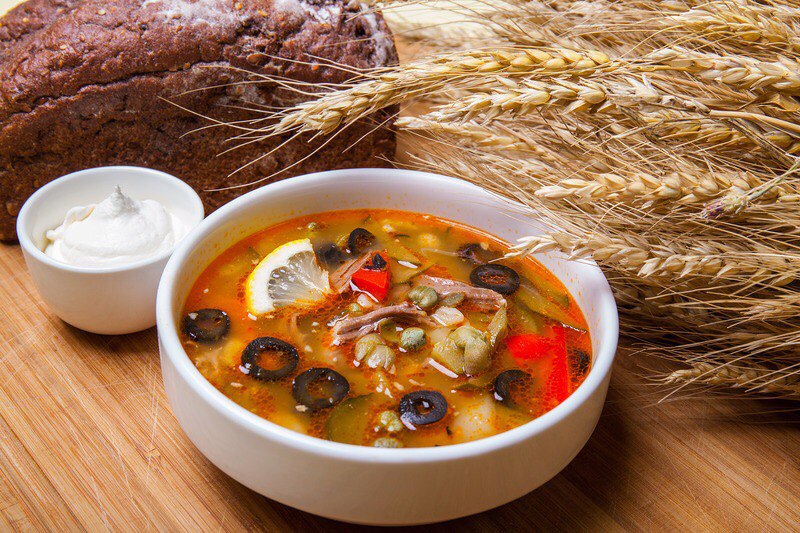17 ethnicities and their cuisines
If the Russian cuisine hasn’t made it big in your life, that’ll leave one more facet of Russian culture to discover while you’re travelling to the Volga region. You may have heard something about Russian traditional meals but have had little opportunity to try them. Travellers to Russia are often surprised at the variety and flavors of Russian cuisine. So, get the unique chance to try it and later your friends will have you searching for the recipes you return home!
So, what are the most common foods on a traditional Russian table? To answer this question, let’s stick to the history of Russia and observe what influenced the Russian cuisine for centuries.
Russia has a history of a cuisine based on crops that can thrive in cold climates, such as grains, root vegetables and cabbage. In the 16th century one of the Russian tzars brought Italian craftsmen to Russia to build public buildings. These craftsmen introduced pasta, frozen desserts and pastries to the Russian cuisine.
Later Peter “The Great” (ruled in the 18th century) included a French chef in his court. It was during his reign that Russians began to serve meals in courses, rather than to serve all the food at once. From that time until the Russian Revolution in 1917, many wealthy Russian families employed French chefs. When French chefs returned home to France, they introduced popular Russian dishes to the people of Europe. The Salade Russe, known in Russia as Salat Olivier or Salad Rusky was created during the era of Nicholas II (in power until 1917) by a French chef.
From the time of the Russian Revolution in 1917 until 1981, all of the restaurants in Russia (then part of the USSR) were owned and operated by the government. Most stores were run by the government, too. In 1981 President Mikhail Gorbachev began reforms that culminated in the 1991 with breakup of the USSR and the democracy period. But the sale and purchase of food was still regulated by the government as of the end of the 20th century.
Historically Russian cooking relied on a pech’ or oven, rather than a burner as a heat source. The pech’ also heated the homes of the peasants, and therefore occupied a central spot in the main room of the house. Traditional dishes included roasted meats, vegetables, soups, and stews. A highlight of the Russian cuisine was dark bread. Also popular were bliny (thin pancakes), and a variety of savory and sweet pies called either piroghi (large pies) or pirozhki (small pies). They were usually filled with fish, cheese, jam, cabbage, mushrooms, chopped hard-cooked eggs, or meat. Borshch, Shchi or Ukha (fish soup) were served as a starter. Hot sweetened tea, called chai, was served frequently from a samovar (large brass boiler) that heated water and steeped the tea leaves to form a concentrated mixture.
Many Russian cuisine traditions were under control of the Russian Orthodox Church, therefore Russians ate much fish because many days of the year were fasting and fish was one of the meals allowed. Bliny was a traditional Russian dish that were eaten in great quantity during Maslyanitsa (Butter Week, the Russian equivalent of Mardi Gras). They were served with sweet or savory filling, with butter, sour cream, caviar, honey or smoked fish. For Easter, Orthodox Russian women baked kulichi. Pashka, a cold mixture of soft cheese (tvorog), butter, almonds, and currants, was formed in a special mold shaped like a pyramid with the top cut off to represent the tomb of Jesus.
Most meals of the historical Russian cuisine are still on the traditional Russian table and served in cafes and restaurants. But as in the most part of Europe you can also find different types of cuisines there due to the recent trends and tourists demands. Also, the Volga region and Saratov are the remarkable area due to many nationalities friendly living close to each other and sharing the secrets of their national cuisines. The total amount of nationalities living on the territory of the Saratov region is about 17. Imagine how many delicious meals you are able to try during your journey?
To make your trip more and more convenient and “appetizing” we would like to share some spots that are really worth visiting:
|
Type |
Average bill for 1 person (with alcohol) | |
| Churchill Steak house | Steak house, restaurant, art club, pub | 20-80 GBP |
| Soho | Restaurant, pub, craft beer, disco | 20-150 GBP |
| Veranda | Italian restaurant | 20-50 GBP |
| Harat’s | Irish pub | 20-50 GBP |
| Tary-Bary | Russian, Ukrainian restaurant | 20-50 GBP |
| Asian style | Asian cuisine | 20-50 GBP |
| Brudershaft | Pub, restaurant | 20-50 GBP |
| Look restobar | Disco bar, restaurant | 10-20 GBP |
| Uzbechka | Tea bar, restaurant, Middle east cuisine | 10-20 GBP |
| Papa’s pub | Irish pub | 10-20 GBP |
| Central Perk | European and Italian cuisine | 10-20 GBP |
| U Andre | Genuine Italian restaurant | 10-20 GBP |
| Myaso Steak bar | Steaks and burgers | 10-20 GBP |
| Machine head | Bar, live music | 10-20 GBP |
| Love sushi | Asian cuisine | 10-20 GBP |
| Kofe i shokolad | Coffee house | 10-20 GBP |
| Coffee 3 | Coffee house, burgers, sandwiches | 10-15 GBP |
| Ulei | Cafe, Russian cuisine | 10-20 GBP |
| Matryoshka | Cafe, Russian cuisine | 10-30 GBP |
| Pasta bar | Fast-food, pasta | 10-30 GBP |
| Mcdonalds | Fast-food | 10-20 GBP |
| Yablonka | Pastry shop, cafe | 10-20 GBP |
| Spinky | Fast-food, noodles | 10-30 GBP |
| Subway | Fast-food | 10-20 GBP |
| Dodo pizza | Pizza |
3-6 GBP |
Get the most out of your journey tasting the unique and special Rusian food!




I have a question!